The Wing Inflatables Story
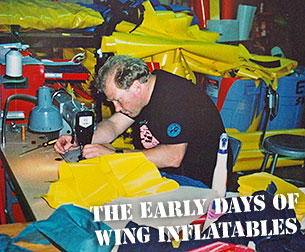
Bill Wing
Growing up in Humboldt County, California, a rugged location uniquely situated between a coastline regularly battered by huge winter swells and mountain rivers filled with class 5 rapids, Bill Wing was in the ideal location to found Wing Inflatables.
Bill's Early Years
The year was 1965. Bill Wing's father, Lowell, who was weighing a job offer in Humboldt County, described to his young son the fierce winter storms blowing in off the Pacific, and the north coast rivers in flood, washing giant redwoods downstream and like monster battering rams, taking out highway bridges and wiping out entire towns. The question was then asked, would young Bill like to move there? The answer was, of course, an emphatic "Yes!"
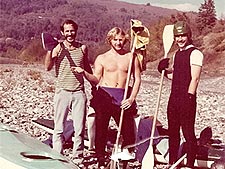
Bill Moves to Humboldt County
It was in Humboldt County that Bill not only learned to love the outdoors, but moreover acquired the myriad skills needed to master them. Founding Yukon Kayaks in an old barn with his father and brother Tim, the family partners laid up various watercraft to explore the many creeks and rivers along California's North Coast.
From his neighbors and good friends across the backyard fence, Bill rubbed up against ingenuity, creativity, patience, and persistence demonstrated first-hand. They worked a mining claim for gold, flew their own airplane, and labored for over a decade building a trimaran for their retirement years. Their ability to take the long view, and their hard-won skills and dedication to achieving their goals was an inspiration to Bill.
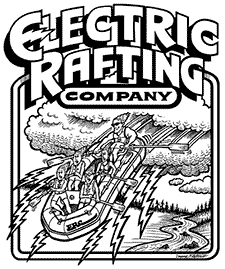
The Electric Rafting Company
After almost earning a bachelor's in music with a focus on jazz guitar, the river called to Bill and 'The Electric Rafting Company' was formed- running commercial whitewater trips on the Klamath, Trinity, and Salmon Rivers; 'electric' because according to Bill his clients were so 'shocked' at the intensity of the trips. In all honesty, it wasn't the 'intensity' that was shocking, but more likely the sing-alongs and shenanigans around the campfires. But all that's for another time. ERC, as it was known, also ran coastal safaris along Humboldt's rugged and remote 'Lost Coast' running rafts in and out of rock-choked 'dog hole's where small lumber schooners had plied their trade a century before.
Introduction to Polyurethane
As a river outfitter running class 4 and 5 runs river safety and swift-water rescue techniques came with the territory. Bill got involved in teaching swift-water rescue to various state and federal agencies including special ops contingents from the military. Wedding this experience and network of users with off-season work as a raft designer, Bill was becoming an acknowledged expert in his field-outfitter, guide, boat-handler, and people wrangler, intimately familiar with all things riverine, oceanic, and inflatable. It was about this time that a new welded-fabric called 'polyurethane' piqued his curiosity. The stuff was expensive but it was tough and strong in ways no other fabric could match. Bill saw the potential of polyurethane for applications far beyond river rafts and created Wing Inflatables in the early nineties to fabricate and promote polyurethane's use in a variety of fresh and salt-water marine craft.
One of Bill's early target markets was the Navy SEALs. At the time the SEALs were using Navy 'ten-man's' otherwise known as IBS's (Inflatable Boat-Small) utilizing technology dating back to WWII. Patching and repairing boats was part of the training process. It took almost ten years, but eventually the Navy and the SEALs came around to the benefits of polyurethane . Every IBS the Navy uses is made of Wing polyurethane.
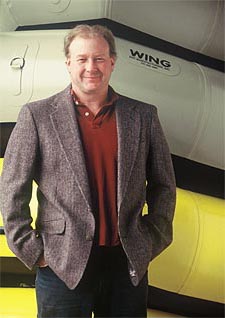
Wing Inflatables and Polyurethane revolutionizes the Rigid Inflatable Industry
In 1991, the same year Bill earned his 500 ton master's (Captain's) license, an aluminum boat builder in the Seattle area, ALMAR, decided to give polyurethane a try. The polyurethane air-holding tubes designed by Wing Inflatables for ALMAR and adopted to a fleet of RIBs, (Rigid Inflatable Boats) for use on off-shore tours in Hawaii were the first of their kind. Soon after in '92, the Navy came back to Wing for polyurethane tubes on its Explosive Ordnance Disposal craft.
In 1993 the various claims and counter-claims relating to all marine air-holding fabrics by their various promoters, Wing among them, had risen to a level where the Navy needed clarity as to how to best move forward with air-holding tube technology. Polyurethane fabric, and by association Wing Inflatables, it's sole user and promoter, underwent an intensive in-depth study along with Hypalon, Neoprene-coated polyester, vulcanized rubber, and PVC, among them.
Among many results favorable to polyurethane the Navy determined that welded fabric was superior in strength to glued fabric, and that in the three critical areas of puncture, abrasion, and tear resistance the polyurethane fabric surpassed all others. A good thing too, because around this same time river-rafts made from less expensive materials coming in from low-wage producers in China and Mexico flooded the commercial raft market. In some instances a completed raft cost less than Wing's raw polyurethane fabric. As river raft sales at Wing stalled and then slowly declined in the face of this off-shore competition, air-holding tubes for RIBs took off.
1997 brought another innovation to the Wing line, significantly expanding the reach of polyurethane into the marine industry. Since the early 1800's cork floats wrapped in sailcloth and fastened to gunwales had been used on small craft by Norwegian fishermen to add stability and floatation. The modern version of this is closed-cell foam wrapped in a fabric sheath. In addition, the Wing polyurethane version featured an air bladder running the length of the collar, inserted within the foam and lying against the hull. When inflated it brought the foam and sheath under tension for rigidity and a clean, wrinkle-free appearance. This air/foam hybrid collar was sought by the Navy, U.S.Coast Guard, and other government and state agencies for the ultimate in performance, shock absorption, and appearance.
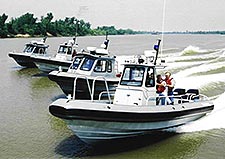
Wing Inflatables today
In the new millennium, polyurethane thermo-welded fabric has become the industry standard, and along with it, Wing Inflatables is recognized as the premium quality fabricator of polyurethane in the world. Lending credence to this claim is the fact that several of the largest river outfitters operating in the US have come home to Wing and polyurethane-forsaking the less expensive rafts for polyurethane's durability and longevity. But today it's not all about collars, sponsons, and rafts. Wing is working with R & D teams in the military, commercial marine industry, and a host of other industries to further wed welded-fabric technology to an exotic blend of applications including stealth technology, ballistic protection, port security, and air-sea rescue among others.

Bill is no longer active in the day-to-day operations. Wing Inflatables continues to grow to ever-greater success and accomplishment mainly because it continues on the it’s been following for over 20 years. From Yukon Kayaks and Electric Rafting Company to Wing Inflatables, make no mistake-the sense of fun, adventure, and possibility remains. Wing Inflatables, like the rivers that originally spawned the company, grows ever more deep, wide, and strong, as it gathers itself and moves inexorably into the future.

